#nanoplastics
Text
Put down that Dasani bottle and take a gander at some horrible news: there are way more tiny plastic particles in bottled water than previously thought, likely meaning untold deleterious impacts on the human body and our environment.
Researchers from Columbia and Rutgers came out with a new study in the science journal Proceedings of the National Academy of Sciences that detailed how they developed a new optical technique to detect plastics in water "with unprecedented sensitivity and specificity."
Continue Reading.
139 notes
·
View notes
Text
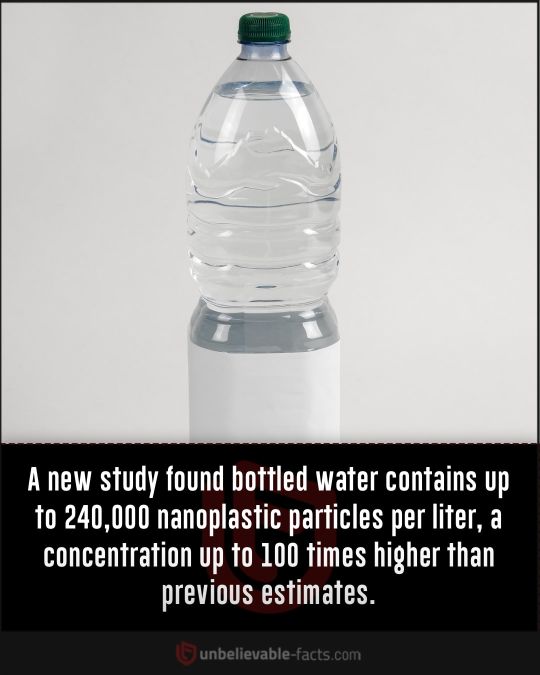
146 notes
·
View notes
Text
Millions of tons of plastic waste enter the oceans each year. The sun's ultraviolet light and ocean turbulence break down these plastics into invisible nanoparticles that threaten marine ecosystems.
In a new study, engineers at the University of Notre Dame have presented clear images of nanoplastics in ocean water off the coasts of China, South Korea and the United States, and in the Gulf of Mexico. These tiny plastic particles, which originated from such consumer products as water bottles, food packaging and clothing, were found to have surprising diversity in shape and chemical composition.
The engineers' research was published in Science Advances.
"Nanoplastics are potentially more toxic than larger plastic particles," said Tengfei Luo, the Dorini Family Professor of Aerospace and Mechanical Engineering at the University of Notre Dame. "Their small size makes them better able to penetrate the tissues of living organisms."
Read more.
#Materials Science#Science#Plastics#Polymers#Environment#Ocean#Nanoparticles#Nanoplastics#Nanotechnology#University of Notre Dame
20 notes
·
View notes
Link
The average liter of bottled water has nearly a quarter million invisible pieces of ever so tiny nanoplastics, detected and categorized for the first time by a microscope using dual lasers.
Scientists long figured there were lots of these microscopic plastic pieces, but until researchers at Columbia and Rutgers universities did their calculations they never knew how many or what kind. Looking at five samples each of three common bottled water brands, researchers found particle levels ranged from 110,000 to 400,000 per liter, averaging around 240,000 according to a study in Monday’s Proceedings of the National Academy of Sciences.
These are particles that are less than a micron in size. There are 25,400 microns — also called micrometers because it is a millionth of a meter — in an inch. A human hair is about 83 microns wide.
Previous studies have looked at slightly bigger microplastics that range from the visible 5 millimeters, less than a quarter of an inch, to one micron. About 10 to 100 times more nanoplastics than microplastics were discovered in bottled water, the study found.
Much of the plastic seems to be coming from the bottle itself and the reverse osmosis membrane filter used to keep out other contaminants, said study lead author Naixin Qian, a Columbia physical chemist. She wouldn’t reveal the three brands because researchers want more samples before they single out a brand and want to study more brands. Still, she said they were common and bought at WalMart. ...
#Environment#OMFG#WTAF#EVIL#plastics#pollution#petrochemical industry#microplastics#nanoplastics#bottled water
11 notes
·
View notes
Text
Microplastics found in nearly all American proteins: Study
7 notes
·
View notes
Text
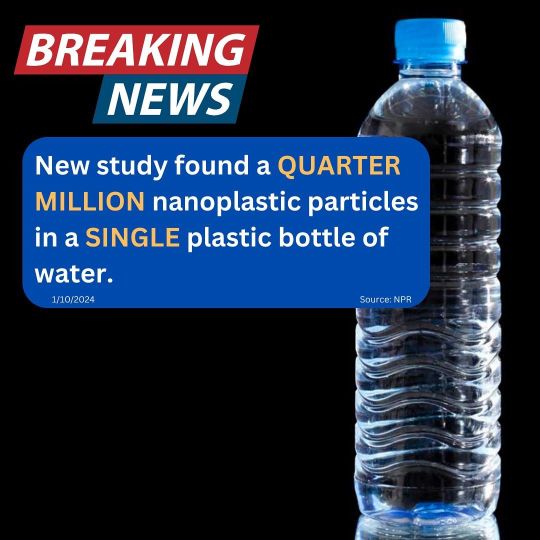

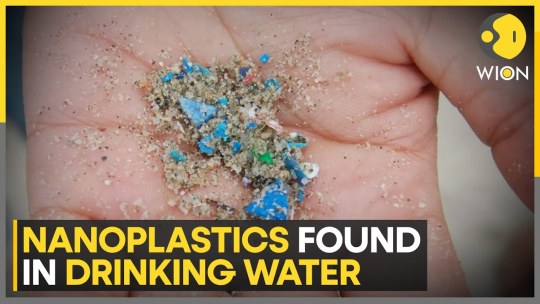

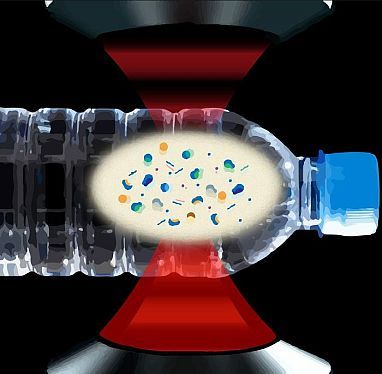
Plastic Particles in Bottled Water
Scientists find alarming amount of plastic in bottled water
Scientists at Columbia and Rutgers have found that bottled water contains high amounts of nanoplastics. There is concern among some scientists that nanoplastics could be small enough to enter the bloodstream and be transported to organs, including the brain. David Schechter reports.
Jan 23, 2024
youtube
The researchers found that, on average, a liter of bottled water included about 240,000 tiny pieces of plastic. About 90% of these plastic fragments were nanoplastics. This total was 10 to 100 times more plastic particles than seen in earlier studies, which mostly focused on larger microplastics.
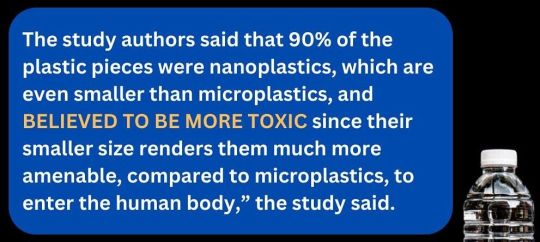
At a Glance
Researchers developed an imaging technique that detected thousands of tiny bits of plastic in common single-use bottles of water.
The technique can help to shed light on the presence and impact of extremely small particles called nanoplastics, which are widespread but poorly understood.
Nanoplastics found in bottled drinking water; 240,000 plastic bits in 1 litre water, says study
Scientists have been warning that a bottled drinking contains plastic - but what is shocking is the amounts that are present in it.
Research done by the National Academy of Science has revealed that a liter of water in a plastic bottle contains an average of 240,000 fragments of plastic. This is 100 times more than the previous estimates. The study is the first to evaluate bottled water for the presence of nanoplastic.
Nanoplastics pose a greater threat to human health than microplastics. Scientists say that they are small enough to penetrate human cells enter the bloodstream and impact organs nanoplastics are also known to pass through the placenta into the bodies of unborn babies.
Scientists have long suspected the presence of plastic Nano particles in bottled water but they lack the technology to identify them to overcome this scientists invented a new microscopy technique and programmed a data driven algorithm to analyze bottled water for the presence of nanoplastic.
youtube

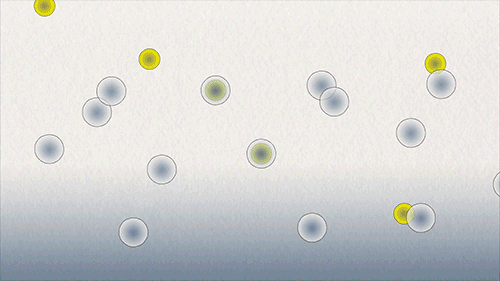

6 notes
·
View notes
Text
France24 - Bottled water contains hundreds of thousands of plastic bits:
#bottledwater#microplastics#nanoplastics#plastics#pollution#stimulatedramanscattering#srs#environmentalscience#health
5 notes
·
View notes
Text
As reported in the journal Science Advances, the findings create a foundation for a new area of investigation, fueled by the timely impact of environmental factors on human biology.
“Parkinson’s disease has been called the fastest growing neurological disorder in the world,” says principal investigator Andrew West, professor in the pharmacology and cancer biology department at Duke University School of Medicine. “Numerous lines of data suggest environmental factors might play a prominent role in Parkinson’s disease, but such factors have for the most part not been identified.”
Improperly disposed plastics have been shown to break into very small pieces and accumulate in water and food supplies, and were found in the blood of most adults in a recent study.
“Our study suggests that the emergence of micro and nanoplastics in the environment might represent a new toxin challenge with respect to Parkinson’s disease risk and progression,” West says. “This is especially concerning given the predicted increase in concentrations of these contaminants in our water and food supplies.”
Continue Reading.
59 notes
·
View notes
Link
Excerpt from this story from EcoWatch:
A new study finds how nanoplastics journey up the food chain, from being absorbed from the soil by lettuce, moving to insects, and eventually winding up in fish. The authors note this could pose potential health risks if this process is replicated with other crops and organisms.
There’s been growing concern about the presence of microplastics, which measure 0.1 to 5,000 μm, and nanoplastics, which measure 1 to 100 nm (0.001–0.1 μm). Recent studies have found microplastics in human lungs and blood, and nanoplastics have even been found in the remote North and South Poles of the Earth.
New research from the University of Eastern Finland now shares how nanoplastics may move upward through the food chain, using lettuce as an example. Researchers developed a metallic fingerprint-based technique that measures nanoplastics in the soil. In the study, the researchers tested this technique with a model food chain consisting of three levels: lettuce, black soldier fly larvae and the insectivorous fish.
For the study, the researchers exposed lettuce plants to soil contaminated with common plastic waste, including polystyrene and polyvinyl chloride nanoplastics, for two weeks. Then, the lettuce was harvested and fed to the black solider fly larvae for 5 days. Next, the insects were fed to the fish for five days.
In the experiment, the study authors then used scanning electron microscopy on dissected plants, insects and fish and found that the nanoplastics from the soil were absorbed through the roots of the lettuce and into the plant leaves. When the insects ate the lettuce, they also consumed the nanoplastics, which remained in their mouths and guts after 24 hours. As for the fish, the nanoplastics were found in the gills, intestines and primarily in the liver. Researchers noted that no nanoplastics were found in the fish brains.
11 notes
·
View notes
Text

View on Twitter
New study finds that when everyday plastic products are exposed to hot water, they release trillions of nanoparticles per liter into the water, which could possibly get inside of cells and disrupt their function
(Source)
5 notes
·
View notes
Text
Scientists tested 3 popular bottled water brands for nanoplastics using new tech, and yikes - Upworthy
2 notes
·
View notes
Text
Wait -- it can't be - laundry detergent can disolve polylactic acid - that's awesome!!
1 note
·
View note
Text
Microplastics and Nanoplastics in Atheromas and Cardiovascular Events
There has been a lot of talk about pollution these days, a phenomenon that is also bad for the heart. But how? An Italian study, the first to have identified the presence of microplastics directly in human arteries, highlights a previously underestimated aspect.
After finding them in humans in several organs and tissues, including the placenta, breast milk, liver and lungs, including heart…

View On WordPress
0 notes